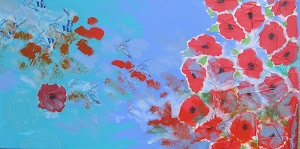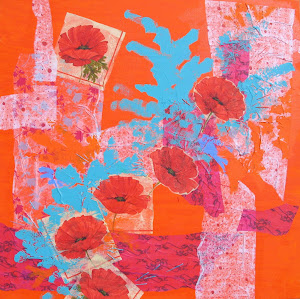What steps can I take to make the art room more "green"? Seems no matter how hard I try to stop the wasting of paper in my room, there is inevitably a LOT of paper waste, among other things. More and more these days I have become increasingly proactive in my personal life about living in a more environmentally friendly way. My husband and I eat organic at home, we often carpool, we use organic soil and fertilizer in our garden, etc, etc, etc.
In my classroom, we have rules in place for hand-washing to limit paper towel and water usage. We have a recycling bin for leftover scraps. I hardly ever let my students start over on a new sheet of paper (which is really a great lesson in creativity and flexibility as well). We incorporate things into our art-making such as newspaper and used cardboard. But it just doesn't quite seem like enough. Please leave some comments - tell us about your ideas for keeping the art room green (you get bonus points if it also help us save money!)
Places to PLAY!
-
During our first semester this school year, Kindergarten through Second
Grade excitedly explored the possibilities of *paper sculpture* as they
constructed...
13 years ago

































17 comments:
Hmm. Good question. I try to not waste, but I honestly can't think of many ways that I am "green" in the art room beyond that. I'll be curious to read what others have to say.
I teach art at an elementary school..To re-use crayons I have the students tear the paper off broken crayons and I break them, put them in candy molds, place them in the oven, then let them cool...My students love the mixed colored crayons!
Keeping green is definitely something I struggle with in the art room. Paper waste is easily my biggest offense. One thing that I've started doing though is with unclaimed/no name art, I cut it up into 1" or 2" squares, small enough so that you can't tell who or what it was, and use it as special collage paper. I also try to cut up scraps into "neater" shapes every couple months and encourage kids to reuse them. I keep scrap bins for each color, which makes maintaining a little bit easier and also looks more appealing to the kids.
Also, I rarely cover my tables in paper, except for maybe 1 or 2 projects each year. Instead I keep a bin of damp sponges, and let kids wipe down the tables at the end of each class. Keeps them focused during clean up, and saves paper for something else!
I'm looking forward to hearing what others have to share!
I posed this same issue to my fifth graders this year. The biggest thing was wasting paper towel while trying to dry the tables after soaking them with wet sponges. UGH! I asked the kids to make a video about being green when it's time to clean. This is what they came up with:
Let's Be Green Movie
My other students really enjoy it and get the message pretty quickly without feeling lectured to.
inspiring!!!
We as an enrichment team could send out a monthly newsletter (via blogs, BG website, and emails) to parents with updates on what's going on in enrichment as well as asking for a kind donation of supplies for upcoming units. A lot of the parents have supplies at home (old crayons, egg cartons, construction paper) that they might throw away. Instead, we could incorporate the 3 R's (recycle, reduce, reuse) and get some great supplies donated! Since the teacher room fund has also been cut, we will not be paying from our own pocket, too!
I actually just created a website for this exact purpose. I'm an elementary art teacher and I've been trying to go green. As a part of my master's thesis, I created a web site about ways to go green in the art room. In the discussion section of the site, there is a link to a ning page that I have set up for discussion about going green in the art room. I hope everyone will check it out and join so we can exchange ideas. My site is www.greenartroom.com
Thanks for sharing everyone! I have been feeling more and more inspired by this topic - I am getting some great ideas for this upcoming year!
I LOVE the Let's Be Green movie - I will definitely be showing it to my students!
Zach, your website is awesome! Thanks for gathering such great resources and ideas! I loved checking out Michelle Stizlein's art, can't wait to show my students and start up some bottlecap art units this year!
I'm planning to post a few pictures of the bottle cap mural that my students made this past school year. I just need to run into school at some point in time to photograph it.
My students sketch out ideas before we work on a final project. The sketch paper is usually just copy paper but it prevents mistakes and waste on the larger and more expensive final project paper. I have also had to break them of the free-draw habit that the previous teacher let them do. They would rush through a project just to free draw. So I now have a bucket of paper scraps (colored, white and tagboard) that the students can create collages or paper sculptures with that when they are done. We have a 2 towel rule for paper towels, and extra large bin for recycling papers, use sponges for big water messes, newspaper for tablecloths. Anything that is plastic gets washed and reused. I bought 4 crayon makers this year (off ebay) and shaped cookie sheets for a crayon project I do with my 4th graders to recycle crayons. I try to teach conservatism and reusing in my classroom. Students have a tendency to use alot of whatever you give them. I teach simple things: dots of glue, not globs,- use small papers for small things, how to cut shapes out of paper (they take a large sheet and cut a tiny circle right out of the middle!). Teaching little things like this can conserve because its inevitable that we will use things. hope this helps
great tips, Michelle! I love your idea to take the place of "free draw". I think one of the most realistic ways we can be more green in the art room has to do with the little ways we help kids learn to reduce waist, which makes a BIG difference! it's so great to hear how everyone does that in their own classroom!
I just recently got pictures of the bottlecap mural up on my blog. It is the very top post at the moment.
http://thomaselementaryart.blogspot.com/
It was a lot of work but I've already gotten a lot of positive comments from other teachers and parents!
Hi everyone - just wanted to share how excited I am that the art room is officially GOING GREEN this year! I decided to document our effect by starting yet another blog. Please check it out (there's a link on the main page), and thanks for all your input!
www.greenartbriargrove.blogspot.com
To keep "green" in my classroom, I create a Fridge List to go home with the students at the beginning of the year. On the list are items like: Cardboard, feathers, ribbon, empty cereal boxes, old cards, beads, fabric, magazines, etc. All things we can make into art projects. I call it a fridge list because the parents can keep it on the fridge throughout the year and if they are going to get rid of things, it reminds them to send the objects along to school to make art out of them. The kids love to recycle and are bringing in tons of great stuff!
At my school I've created a Fridge list to help us "Go Green." The fridge list is a note for the parents to hang on their refrigerator and when they come along things in their house that they might consider junk, they can send them to school so we can make art out of them. Some examples are: cardboard, empty cereal boxes, string, paper towel tubes, yarn, beads, feathers, wrapping paper, ribbon, fabric, styrofoam (clean), packing peanuts., etc. I've even had a mom donate tons of cigar boxes for the whole school to make dioramas! The kids are really excited to help recycle and we make some really cool art that's recycled!
I love the "Fridge List" idea! Thanks!
I work at an environmental awareness charter school. I use NO PAPER TOWELS in my art room. Instead I have a supply of cloth napkins (picked up at yard sales) in a big brown basket. We use (and re-use) these cloths for all of our watercolor, paint, water, and other mess-based projects. We even use them with our green cleaning supplies to clean glue and dried paint off of the tables. When they are ready to be washed I take them home and throw them in with other laundry I'm already doing. When I started out with this plan in mind, I wasn't sure it was going to work, but it does! My students are used to using the cloths and there is no waste.
Post a Comment